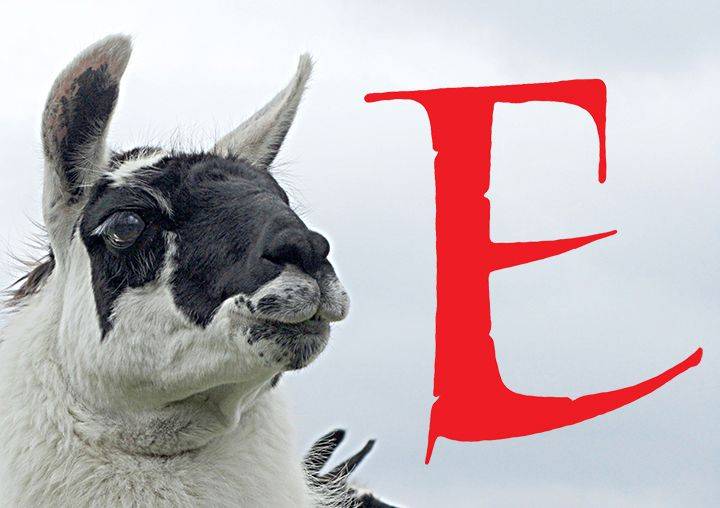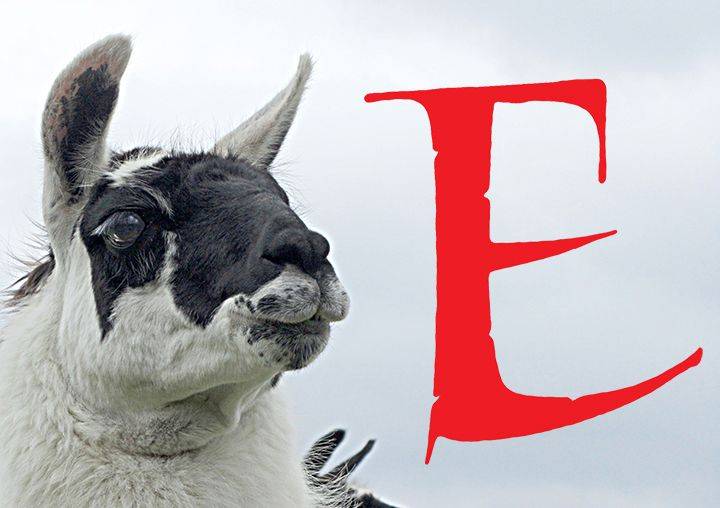 E is for eye. I encountered this particular llama eye at the Geil Homestead in Mahomet, where it has prospered for some 15 years, acquired specifically for the power of its stare. Tammar and Phil Geil have an intriguing assortment of animals, plants, and alternative sources of energy on their country expanse. For them one thing leads to another, including the mother of the emu egg I bought at their stall at last summer’s Urbana Farmer’s Market. And that’s another E, isn’t it…
E is for eye. I encountered this particular llama eye at the Geil Homestead in Mahomet, where it has prospered for some 15 years, acquired specifically for the power of its stare. Tammar and Phil Geil have an intriguing assortment of animals, plants, and alternative sources of energy on their country expanse. For them one thing leads to another, including the mother of the emu egg I bought at their stall at last summer’s Urbana Farmer’s Market. And that’s another E, isn’t it…
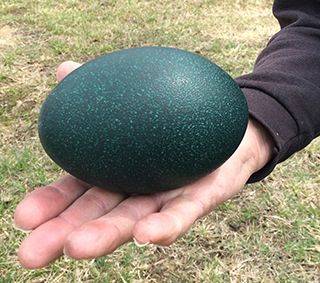
Some years back the Geils raised sheep, and were troubled by dog attacks. Being creative problem solvers, they did some research and found that llamas are powerful protection against coyotes and dogs, because of their aggressive stare, charge, and alarm cry. And so the Geils acquired their first trio from a breeder in Wisconsin. Currently the homestead has a charming quartet, increased by the birth of Frigid, the cute little one you see here, born on the coldest day of the year.
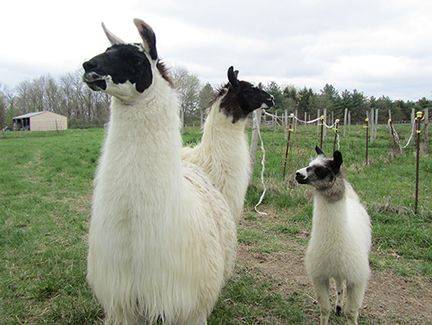
These unexpected Illinois neighbors are in the camelid family, herding animals from the Andes and plains of South America. They are more affordable than another guarding breed, alpacas, which can go for upwards of $10,000 a trio. Phil Geil tells me his llamas are as intelligent and companionable as a dog, don’t kick or require shearing, and provide high quality fertilizer. They do well through Illinois winters but are grateful for a fan in summer heat.
I found this bit of information so intriguing that I began an extended meditation on ‘Eyes one might Encounter’ in Champaign/Urbana and vicinity. I’d enjoy your company for some springtime curiosity.
 An eye can stare you down; an eye can welcome you in. Depending on the receptors your particular eye has, it will open you to quite different worlds. The human eye perceives light in the Red Green Blue spectrum. The most complex eye for color vision out there just might be the mantis shrimp, which can see a hyperspectral array. Imagine walking down Green Street in a hyperspectral world.
An eye can stare you down; an eye can welcome you in. Depending on the receptors your particular eye has, it will open you to quite different worlds. The human eye perceives light in the Red Green Blue spectrum. The most complex eye for color vision out there just might be the mantis shrimp, which can see a hyperspectral array. Imagine walking down Green Street in a hyperspectral world.
You’re not likely to meet a mantis shrimp for casual conversation in C-U, but your dog has quite different perception from yours unless you are green / red colorblind.

Expand your inquiry to the insect world and enjoy the tetrachromatic world of the butterflies and bees in your backyard. It’s a pity we the people are limited to trichromatica.
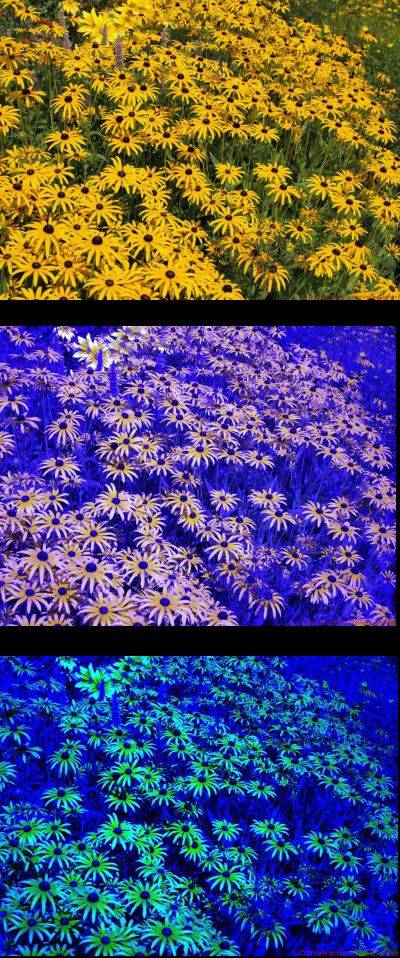
[The human view on top, butterflies in the middle and bees on the bottom, thanks to Dr. Klaus Schmitt]
The eye is a vulnerable part of one’s anatomy; the canny attacker will take advantage of that. And so nature in her wisdom has developed some intriguing camouflage. Just this morning in my back yard I admired the handsome coloration that protects these visitors from eye assault.

[Red breasted nuthatch; White capped sparrow; unidentified visitor]
The arrival of This Spring, after This Winter, has me practically punch drunk with flowers, scents, sunshine, and wanting to be out there in the awakening world. And once I started thinking about eyes, they appear in interesting places.
There’s something powerful in the shape of an eye, whether it’s the real thing or a likeness, that says “look at me!” to my ancient genes. These handsome examples live in our very own U of I Arboretum in the southeast expanse beyond Lincoln and Florida in Urbana.
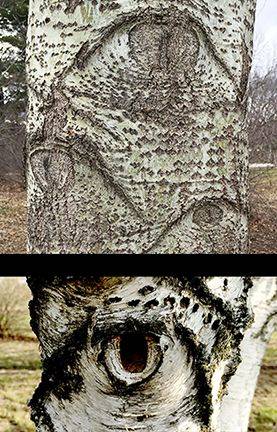
[Above: Populus alba, White Poplar, a relative of aspen; below: Betula papyrifera, White Birch]
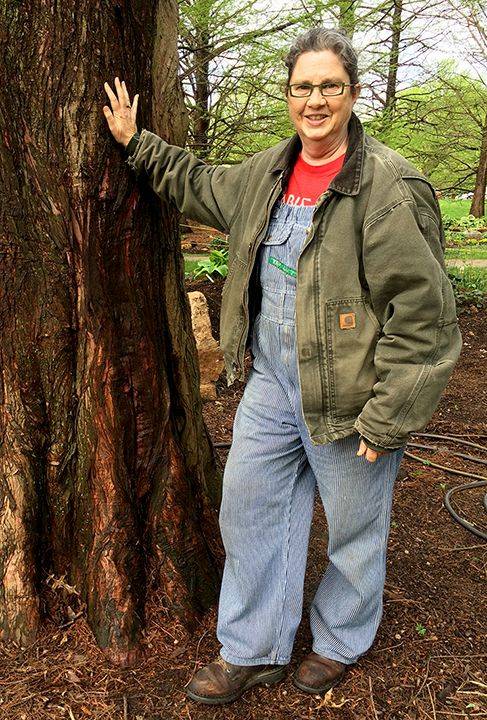 A useful person to know for tree questions is Diane Anderson, U of I horticulturist. She oversees the arboretum’s 60 acres with staff and volunteers, including the master gardeners who tend the Idea Garden, and members of the Illinois Prairie Hosta Society, who were out working the particular morning I consulted on bark patterns. Anderson explained that the circular eye shapes are scars formed when branches are removed to limb the tree off the ground. The eyebrows are the “branch bark ridge,” something every tree has above every branch.
A useful person to know for tree questions is Diane Anderson, U of I horticulturist. She oversees the arboretum’s 60 acres with staff and volunteers, including the master gardeners who tend the Idea Garden, and members of the Illinois Prairie Hosta Society, who were out working the particular morning I consulted on bark patterns. Anderson explained that the circular eye shapes are scars formed when branches are removed to limb the tree off the ground. The eyebrows are the “branch bark ridge,” something every tree has above every branch.
Now that you’ve joined me inside the Arboretum, let’s include one more encounter at Japan House. From naturalist philosopher Henry David Thoreau, in his magnum opus Walden: “A lake is the landscape’s most beautiful and expressive feature. It is earth’s eye; looking into which the beholder measures the depth of his own nature.”
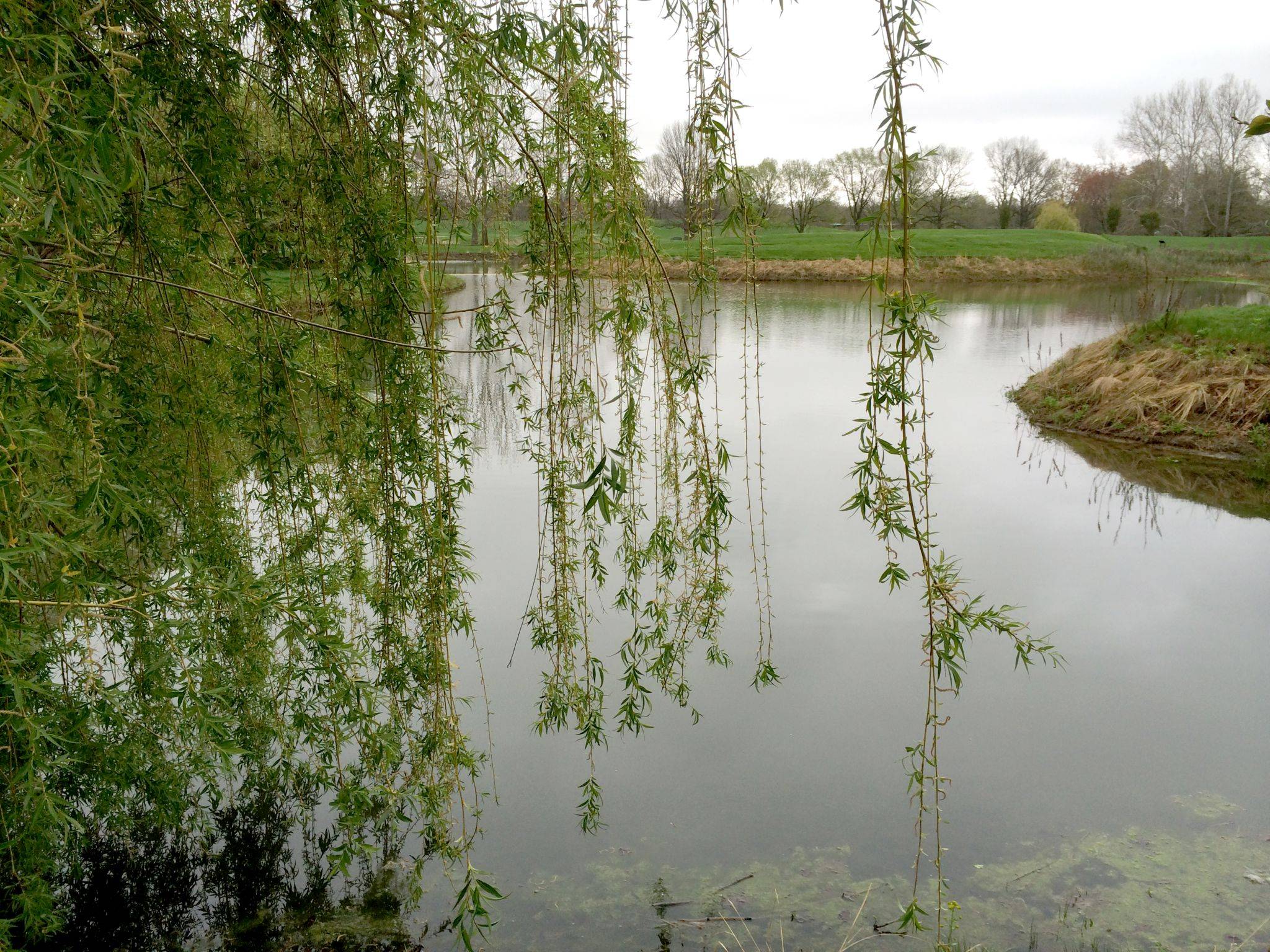
Don’t stop with the lake and gardens outside Japan House, although they are deserving of as much time as you’d like to tarry. Inside, once you’ve shed your shoes as is polite in Japanese interiors, you can sample the world of aesthetics offered through exhibits, courses, and public offerings under the umbrella of the U of I’s College of Fine and Applied Arts.
Several times a year, Professor Emeritus Shozo Sato offers classes in the art of Japanese calligraphy. This is not a mere alphabetic study; when you put your hand to brush and ink you will discover the poetic side of how Japanese characters are composed. It was my pleasure to join the April class and learn the character for Dream. It is made up of the individual symbols, top to bottom, for grass, eye, roof, and evening. Point your mind’s eye toward that.

Sato Sensei, the term of respect for a revered teacher, which he most certainly is, graciously humored me with a master’s rendition of the character for “eye.”
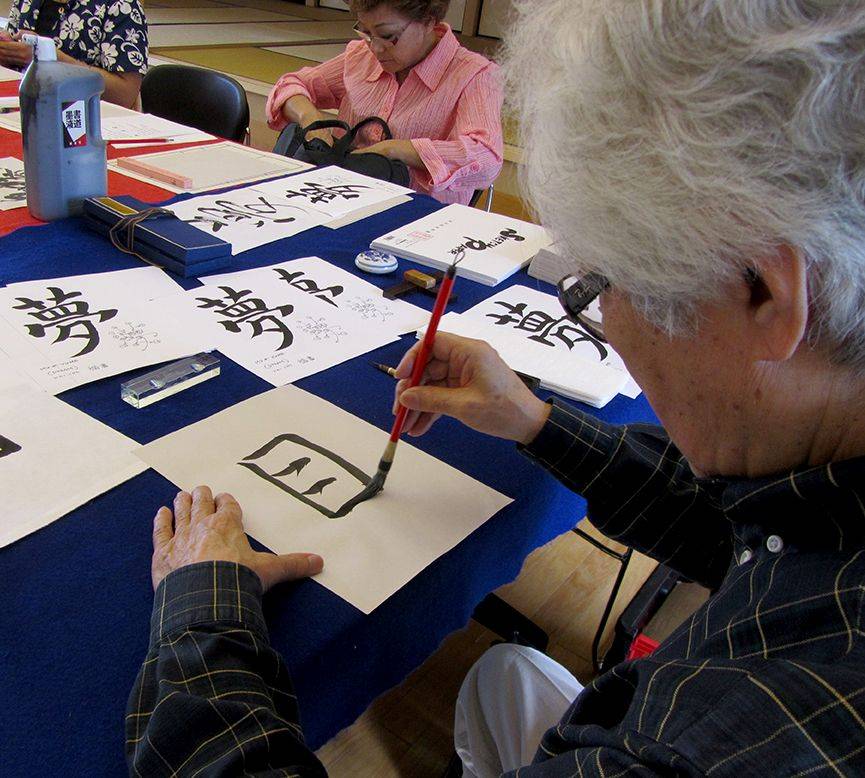
This is not just a movement of the hand and brush. As Sensei instructs his students: sit squarely at the front of your seat; spread legs and feet wide and straighten your spine to make a tripod of your body; breathe deeply until you connect with a spark of the chi, your life force. And — only then — apply inked brush to paper. You can then enact the essence of a living “eye,” from the inside out.
The eye of a storm. While we’re in the natural world, there is a particularly powerful eye to watch for in midwestern tornado season, which peaks in late spring. The first Tuesday of every month at 10 a.m. you will hear the test of the C-U tornado sirens. When you hear these, take note. The fastest winds known on earth may be building, and you would wisely take cover. Here’s one local record, which gives a good view of the funnel that encloses the tornado’s eye.
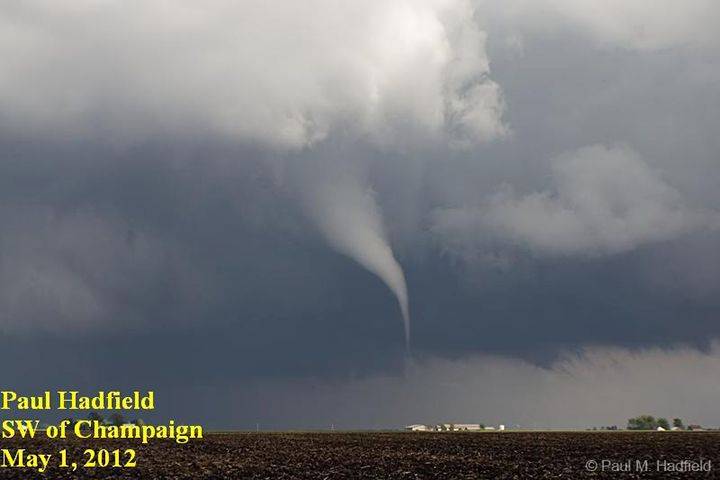
And what would one encounter inside a tornado’s eye? I found reference to two known survivors’ descriptions.
On June 22nd, 1928, a Kansas farmer named Keller stood his ground in the face of an oncoming tornado and found himself inside the actual eye, which he described as a circular shape about 50-100 feet in diameter, half a mile high with a round opening at the top, “as still as death” with a strong gassy smell. He saw continuous lightning flashes across its width, with multiple smaller tornadoes forming and breaking free with a loud hiss. An eye of considerable awe, surely.
There is a mysterious power in eyes, whether it is metaphorical or embodied. I might say that in an eye one can observe the center of a whirling unfathomable reality; or a moment of direct communication between two sentient beings. And that leads us, human or otherwise, to the urge to enhance our own eyes. Let’s close with a celebration of eyes dressed to impress.
If you were at the opera rehearsal room of the Krannert Center for the Performing Arts last Saturday, you shared the delight of the “Re-fashioned Fashion Show” for students of Susan Becker.
 Their fashions are, by assignment, made from found objects. This year’s gala included an astounding array of beautiful, whimsical, and breathtaking fashions crafted from items including trash bags, newspapers, plastic bottles, CDs, graduation tassles, pistachio shells and duct tape. They were showcased elegantly by models on a runway, eyes embellished to enhance their clothes. Another of the magical offerings of this community of ours.
Their fashions are, by assignment, made from found objects. This year’s gala included an astounding array of beautiful, whimsical, and breathtaking fashions crafted from items including trash bags, newspapers, plastic bottles, CDs, graduation tassles, pistachio shells and duct tape. They were showcased elegantly by models on a runway, eyes embellished to enhance their clothes. Another of the magical offerings of this community of ours.
Wherein lies the power and beauty of an eye? Is it in the looking out, or the looking in? And don’t overlook what you may encounter inside your Mind’s Eye.
Ultimately, whatever is to be explored and appreciated is in the eye of the beholder — and that, dear reader, is you.
———
Here’s a look at the letter itself. E is the fifth letter of our Latin alphabet, the most commonly used of all 26, at least in English. The Egyptian hieroglyph q’, a praying person,  was likely the precursor of the semitic hê, meaning Jubilation, for a praying or calling figure.
was likely the precursor of the semitic hê, meaning Jubilation, for a praying or calling figure.
This evolved into the Etruscan and Phoenician forms, a 3-barred upright, either left or right facing:  The Greek epsilon parented our E, in both its forms, upper and lower case:
The Greek epsilon parented our E, in both its forms, upper and lower case: 
Did you know that the terms “upper case” and “lower case” refer to the type cases used in the days of hand composition? Capital, or majuscule, letters were kept in the upper case on the compositor’s bench; miniscule in the lower case.

And with that reference to hand typesetting, I’ll wave a fond farewell to a set of eyes this town will miss. For the past few years a favorite corner of C-U has been The Living Letterpress, overseen by master printer and designer Molly Poganski, whose work and generosity have made this a richer community. Molly is moving with her partner Joel Gillespie, of Smile Politely fame, to Minneapolis. And with that, they’ll be a sight for sore eyes.
Cope Cumpston is a typographer, book designer, and community enthusiast resident in Urbana. You can reach her here: (cope.c@comcast.net).
The archive of abecedarian C-U lives here:
A B C D E F G H I J K L M N O P Q R S T U V W X Y Z








